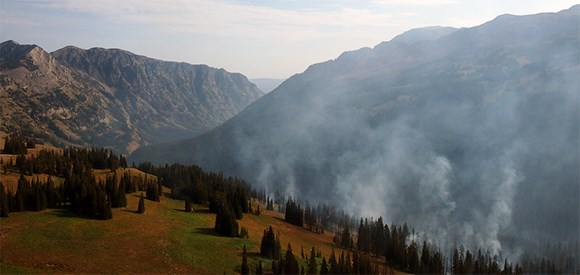Last updated: December 14, 2017
Article
Moose Fire Offers Rare Opportunity for Managing Fire

“This fire offered an opportunity to observe fire behavior in a regime that is not well understood. The whitebark pines in the area were mostly dead from beetle infestation, so this area is a high priority for restoration. The fire will create new sites for whitebark pine seeds to be naturally planted by Clark’s nutcracker in order to regenerate the forest.”—Diane Abendroth, Teton Interagency fire ecologist
Grand Teton National Park, Bridger-Teton National Forest
The Moose fire was discovered on August 3, 2013 by smokejumpers en route to another fire on the Bridger-Teton National Forest. Burning as high as 9,200-feet elevation at the upper end of Webb Canyon in Grand Teton National Park, the two-acre fire consisted of several small spots on the west slope of a ridge in mixed conifers. Park management agreed to a monitoring strategy, as it offered a rare look at fire behavior in whitebark pine and spruce trees at such a high elevation. Initially, two West Yellowstone smokejumpers were assigned to the fire to monitor it and ensure that the Moose Basin patrol cabin was not affected by the fire.
Growth on the fire was gradual at first, as it was primarily creeping and smoldering in ground fuels, with isolated torching. The spread was from tree island to tree island, until one particularly windy day when it spotted across the meadow into more continuous fuels. The Moose fire grew to an estimated 40 acres on August 19, moving eastward into upper Moose Creek. During more active burning periods, monitors observed multi-tree torching and spot fires up to a quarter mile ahead of the main fire. By August 21, the fire had grown to 180 acres. Significant rainfall slowed the growth of the fire, which could still have potential with an extended drying period and windy conditions until significant snowfall.

“This fire offered an opportunity to observe fire behavior in a regime that is not well understood,” said Diane Abendroth, Teton Interagency fire ecologist. “The whitebark pines in the area were mostly dead from beetle infestation, so this area is a high priority for restoration. The fire will create new sites for whitebark pine seeds to be naturally planted by Clark’s nutcracker in order to regenerate the forest.”
Fire effects monitors established photo points in the whitebark pine/spruce stands to monitor the long-term regeneration.
At any given time during the active management of the Moose fire, only minimal local and out of area resources were assigned. These personnel monitored fire growth and developed contingency plans for specified management actions. Management of the Moose fire was accomplished while nationally and in the eastern Great Basin preparedness levels were 4 and 5, respectively.
Contacts: Diane Abendroth, fire ecologist
Email: e-mail us
Phone: (307) 739-3665
